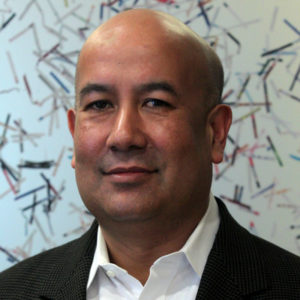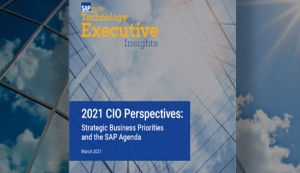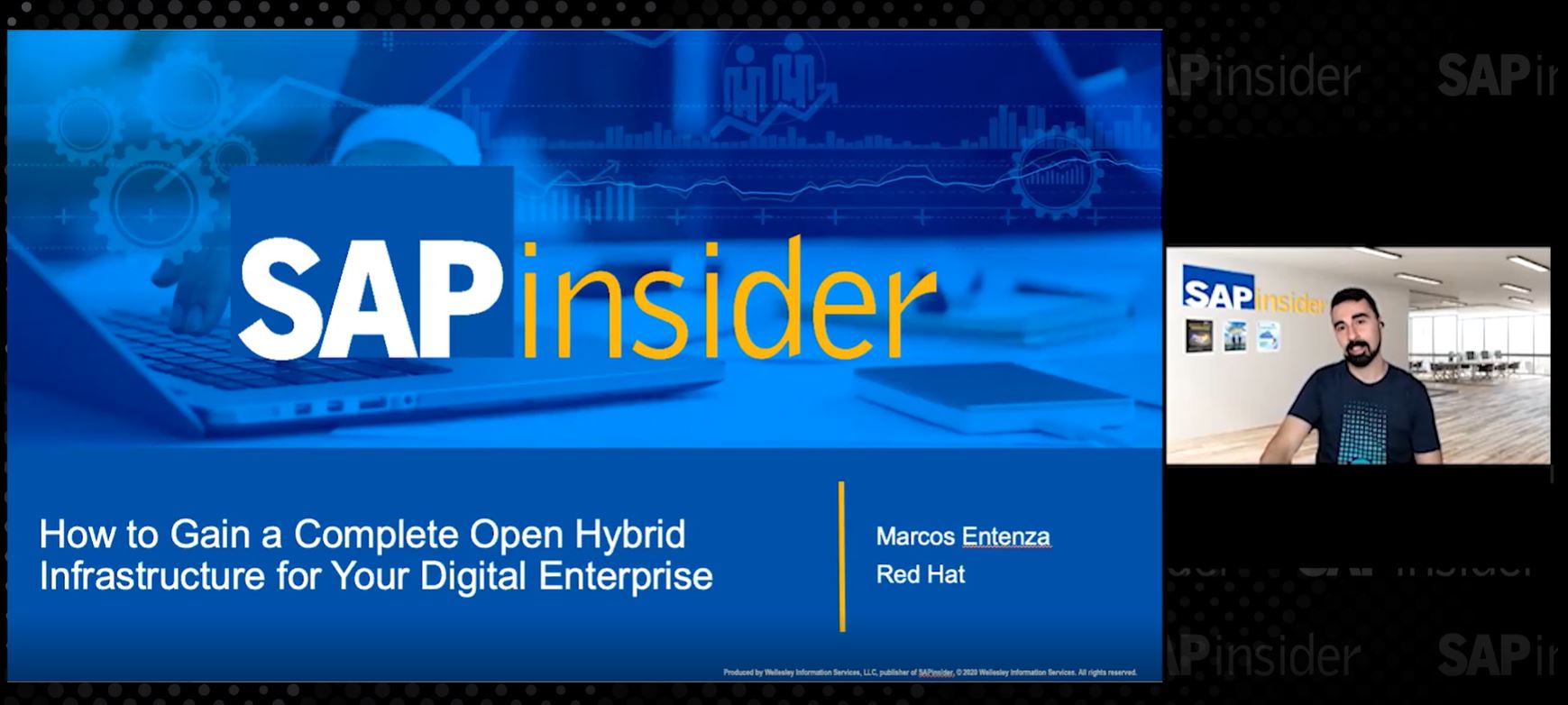How Executives Are Building the Technology Landscapes That Power Business Transformation
by Brianna Shipley, Editorial Director, SAPinsider
Riz Ahmed, SAPinsider’s Chief Research Officer, set the foundation for the July Technology Executive Forum virtual meeting on Thursday, July 15, with a question:
How are companies building technology landscapes that support business transformation?
According to a variety of SAPinsider 2021 survey results, companies are accelerating their plans to move to SAP S/4HANA and the cloud.
In fact, just over half of executives (51%) say that SAP S/4HANA is their most strategic SAP-focused investment in 2021 (“2021 CIO Perspectives: Strategic Business Priorities and the SAP Agenda,” March 2021), with 38% of responding companies reporting that they have already implemented or are in the process of implementing SAP S/4HANA (“Deployment Approaches for SAP S/4HANA,” June 2021).
Survey respondents (53%) selected cloud adoption as an area of significant investment in SAPinsider’s February 2021 “State of the Market Benchmark Report,” with a variety of cloud options being considered.
A concluding theme throughout SAPinsider’s research of and interviews with the community is that implementing next generation technologies is essential to keep pace in the marketplace. However, their capabilities must be applied through a business lens to achieve competitive advantage in today’s evolving economy and shifting workforce models. Decisions about and investments in technology, which have traditionally fallen to the IT team, now require input from and collaboration with the business side.

Key Takeaways from Riz Ahmed, Chief Research Officer, SAPinsider
- Understand the business and innovation implications of your technology landscape
- Link standardization and transformation initiatives where possible
- Think differently about your organizational strategy and current skill sets
- Have an aggressive plan for updating cloud knowledge and training
- Teach and inspire the business on how the landscape and technology transitions can help resolve pain points and support critical strategies
Organizational Structures That Embrace Emerging Technologies
A trend shared by forum members about their digital transformations was re-imagining the business and how IT can support it from the perspective of organizational structure and culture change.
Nuno Miller, Chief Information Officer (CIO) at Sonae Fashion, a producer of worldwide fashion brands that have direct presence in around 400 retails stores in more than 80 countries, described how the company is separating from the retail group to accommodate changing customer behaviors. “We used to have a single unit handling all the different retail parts of the business. Now we have three different pillars as consumers adopt different personas when they purchase food versus electronics versus garments. It’s really our goal to make sure that we have different mindsets for each one of the different customer areas in terms of supporting product development and the agility and speed required to go quickly to market.”

Key Takeaways from Nuno Miller, CIO, Sonae Fashion
- Develop an awareness of your area of expertise.
- Achieve agility — both in project management and product development.
- Adopt a digital mindset throughout the entire organization.
Miller said it requires a “huge mindset shift transitioning from traditional retail into fashion retail where it’s about creating products, designing brands, and developing products to offer customers.” A change in both attitude and technology must occur, he says, to embrace the differentiation between fashion, grocery, and consumer electronics, for example.
Vitesco’s CIO Thomas Buck spoke during his opening keynote session about the German automotive supplier’s strategic commitment to become a leader in electrified solutions.
Buck said that Vitesco’s parent company, Continental Corporation, had everything it needed to be successful in this area, including the electronic and software competence, “so we changed our strategy completely.”
Continental’s powertrain technologies division — which made up 18% of the company’s sales in 2020, according to Buck — is undergoing a transformation “from combustion engine to electrified mobility” resulting in a spinoff business from its parent company.
To bring Vitesco Technologies to life in a short period of time, the IT team duplicated Continental Corporation’s IT landscape, resulting in a much larger SAP footprint than the spinoff needed or could reasonably support, including over 30 SAP development systems, more than 35 SAP production systems, and over five different SAP release levels.

Key Takeaways from Thomas Buck, CIO, Vitesco Technologies
- Don’t underestimate the small changes — and expect surprises.
- Set a single target for the whole team to work towards.
- Balance wishful thinking with reality.
Revisit slides 26 and 27 and review the scope of Vitesco’s transition.
Buck said focusing on a single objective — to achieve lean IT operations — made a huge difference. “If you find a way to bring your whole team behind one single target, you will have a greatly motivated team.”
Michael Mullis, CIO at Ingevity, a leading provider of specialty chemicals and high-performance carbon materials and engineered polymer, related that although Ingevity’s transformation was smaller in scope compared to Vitesco’s, many of Buck’s experiences resonated with his own recent transformation project.

Key Takeaways from Michael Mullis, CIO, Ingevity:
- Expand beyond an IT project into a holistic business transformation mindset.
- Buy storage instead of hardware to increase speed and agility.
- Consider design-thinking tools to realize the “art of the possible.”
SAPinsider interviewed Mullis earlier this year about how Ingevity is pushing the bounds of what’s possible. Read the full story here.
During the virtual meeting, Mullis explained that Ingevity also did a lift and shift from its parent company, resulting in several duplicate systems that were not relevant to the chemicals industry. He made a connection between his tagline at the time, “simplify, standardize, and optimize what we have,” and Buck’s strategic mindset.
Mullis said Ingevity is looking forward to taking advantage of increased planning capabilities and visibility into plant maintenance, repair, and operations (MRO), as well as next-gen technology like robotic process automation, artificial intelligence, machine learning, advanced analytics, and augmented reality. Ultimately, the company will facilitate an agile service deployment model, enabling it to level up services per customer demand.
GEA, a market and technology leader in the food and beverage processing industry, and chemical, pharma, and marine industries, has adopted a strategy involving a complete fundamental transformation and shift in the company’s business model, operations, and processes.
In tandem with a massive greenfield SAP S/4HANA implementation in 2020 (read about it here), the company developed a collaborative IT perspective across business divisions and levels. According to GEA’s CIO Christian Niederhagemann, this required the organization to adopt product-oriented pillars from a sales perspective, with IT aligned to support each of these areas on a local level.

Key Takeaways from Christian Niederhagemann, CIO, GEA
- Accept IT as a business partner.
- Blend together communication and decision-making.
- Bring IT’s knowledge of digitization into the business.
Niederhagemann explained that in the past GEA relied on decentralized IT teams of approximately 30-40 members per region who provided support to each of the company’s locations spanning approximately 70 countries.
GEA is now shifting this approach to a centralized support hub comprised of a mix of IT and business people with limited hierarchies. It is Niederhagemann’s hope that this new organization will foster greater collaboration and more innovation across the business.
“We decided to go for a global, locally centralized approach,” said Niederhagemann, and required “a massive change in mindset” compared to decentralized hubs that served a global need previously.
Don’t Kill Culture
The TEF advisory board panel shifted from the topic of transformation to change management and the criticality of culture. Milan Kumar, CIO at ZF WABCO, an American provider of electronic braking, stability suspension, and transmission automation systems for heavy-duty commercial vehicles, and Nik Giannakakis, CIO of Motor Oil Group (MOG), one of Greece’s largest companies in the country’s energy sector, spoke about compassion.
Kumar encouraged other leaders to be patient in their approach to integrate change. He cautioned against a “my way or the highway” conviction, and instead suggested that a symbiotic relationship between day-to-day operations and progress be reinforced through thoughtful workforce management.
Giannakakis said that in his experience of reviewing many different management styles, he recognizes that security and safety are important to most employees. Considering this element in parallel with the fact that change is challenging for everyone can help magnify the opportunities change presents, such as occasions for employee growth, while also respecting employees’ need for welfare.

Key Takeaways from Nik Giannakakis, CIO, Motor Oil Group
- Focus on how change impacts employees in a positive way to gain buy-in.
- Architectural skills for the IT team will be crucial moving forward.
- Identify ambassadors for change!
He also suggested selecting people who can serve as advocates and ambassadors for change.
For more information about MOG’s deep energy transformation, read SAPinsider’s Member Insight or watch an exclusive executive interview with Giannakakis and MOG’s General Manager of Strategic Planning and Development.
Buck shared that he now directs his change management efforts on the 95% who are open to the shift so they not only accept but become the change (a nod to his earlier advocacy of focus). This prevents the other 5% from negatively influencing the change and helps set realistic expectations about the percentage of people adopting it.
During the breakout session “Leading and Managing in a Hybrid Work Environment” Mullis touched on connection. Establishing a camera-on meeting mentality helps support collaboration and engagement at Ingevity, he said.
When Ingevity built its integrated SAP S/4HANA business platform, which kicked off just as the pandemic required teams to work remotely, Mullis said that keeping tabs on employee burnout and well-being was critical. It’s a leadership approach that remains essential today as many companies operate virtually or enter a hybrid work environment.
Let’s Talk About Skill Sets
How is the traditional SAP team changing? Ahmed asked.
Miller said he is testing a hybrid model at Sonae Fashion where external teams “run the basics,” making sure everything works properly regarding integration, processes, and end-user support. He then has an expert team informing on added-value functions that the company is introducing.
Kumar talked about business orientation as a skill set and the importance of bringing it into the IT community to ensure that IT is not only developing “brilliant solutions,” but that it is also able to conceptualize and communicate its applicability within the business. “We are working to ensure that IT understands the business challenges and that it can create technology to bridge the gap between business and IT.”

Key Takeaways from Milan Kumar, CIO, ZF WABCO
- Pivot from “get them out” to “get them on board” for those slow to change.
- IT should inspire, enable, and encourage.
- Invest in business orientation as a skill for the IT team.
An effective strategy that he sees for IT teams moving forward is cultivating the ability to govern technology without stifling its potential by inspiring people to innovate with the technology and enabling them to use it safely.
GEA, too, is investing in bringing the business attitude to
its IT staff — all the way down to training IT to work with demand managers and understand what’s coming next, according to Niederhagemann. He sees a need for more consultative IT staff to support the business and suggested that these roles may be shifting away from traditional coding.
Giannakakis agreed that infusing business acumen into IT is necessary, and said he sees an additional need for the IT team to develop architectural skills so they can navigate the increasingly complex SAP landscape and SAP partner offerings, selecting the right ones and adding business value.
What Does This Mean for SAPinsiders?
Balance moving fast and slowing down. One of the first words spoken during the virtual meeting to describe market trends was “acceleration.” Speed and agility, along with the concept of failing fast, are undeniably enabling business success today, and yet leaders must get comfortable with holding two opposing concepts in mind: Sprint ahead, but not at the expense of intention. The business ecosystem and the factors that inform competitive advantage are changing faster than ever before and with severe consequences for getting it wrong. Take time to create a culture and organizational structure that support skill sets and decisions made toward your end goal. Leading organizations have proven that focus, thoughtful decisions, and the ability to change course if something isn’t working adds business value over time.
Prepare for a hybrid work environment. Leaders will need to re-think things like employee engagement and burnout, hiring and onboarding, visibility, and flexible work hours, all against a backdrop of enabling technology. Companies (71%) are ultimately planning to invest in a comprehensive employee experience management solution, according to SAPinsider’s “State of Human Experience in the Workplace Benchmark Report” published in June. Keep an eye out for solutions that create an engaging environment for remote employees, like Zoom’s Smart Gallery feature, which helps create an engaging meeting experience for remote employees in a hybrid workforce model, and Webex’s interactive AI-powered “assistant” to help you take notes and set reminders during virtual meetings.
Shatter the wall between IT and the business. Use those pieces to bridge the gap once and for all. This popular buzz-phrase must become a reality. Leading executives are exploring how to put this concept into action by infusing a business orientation attitude and a consultative approach into their IT teams, and introducing IT’s knowledge of digitization to business teams so they can do their jobs independently. The success stories shared during the virtual meeting and those published as part of SAPinsider’s Member and Executive Insight series, including companies like Delivery Hero, Llyod’s Register, and Walgreens Boots Alliance demonstrate that an alignment of IT and business characterizes today’s definition of innovation.








